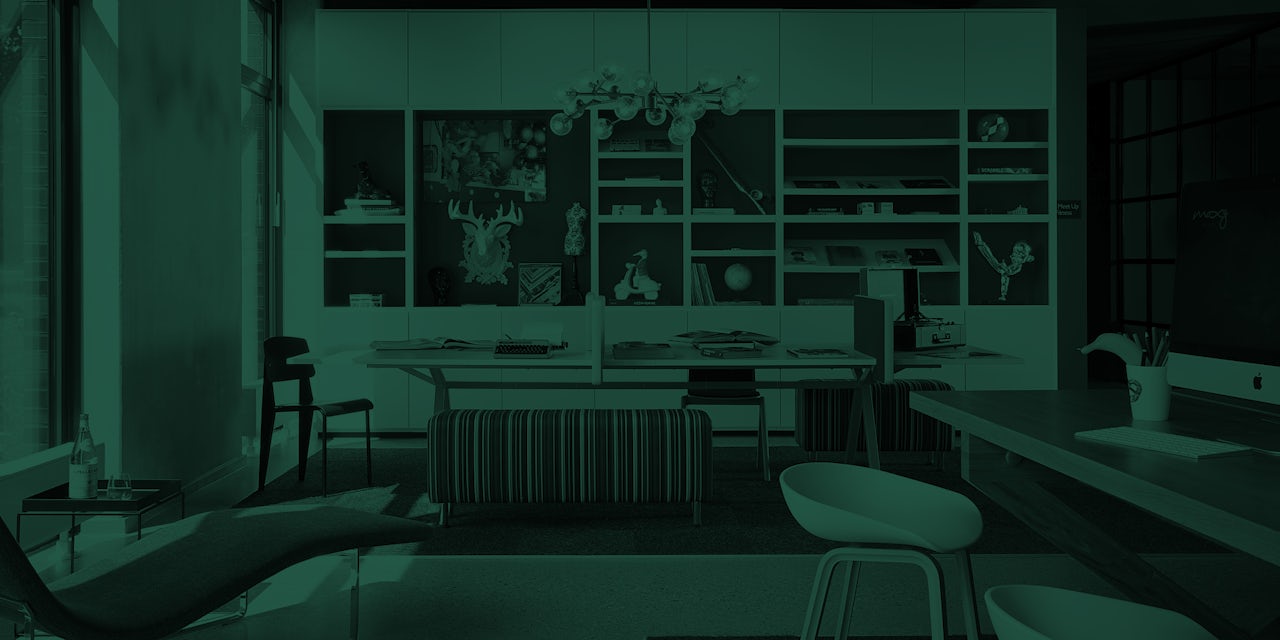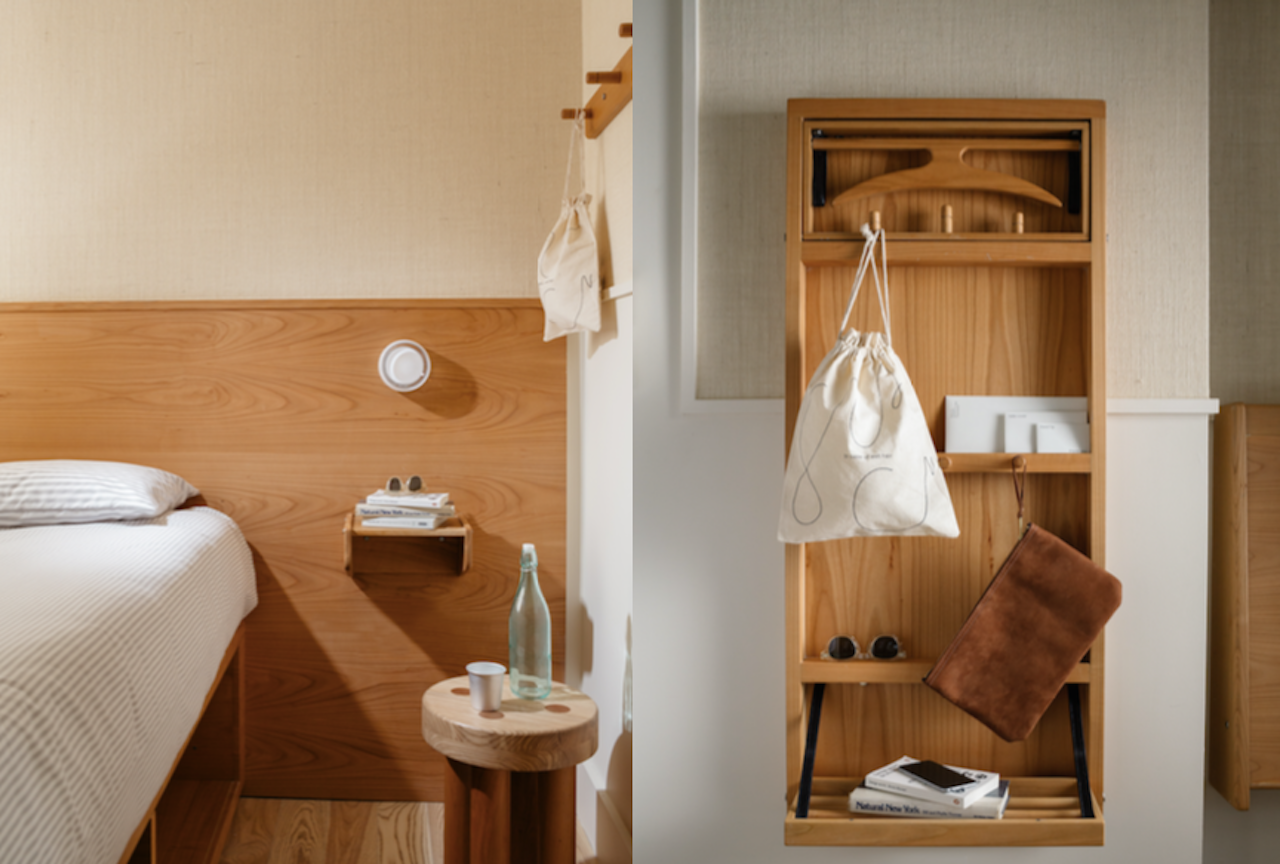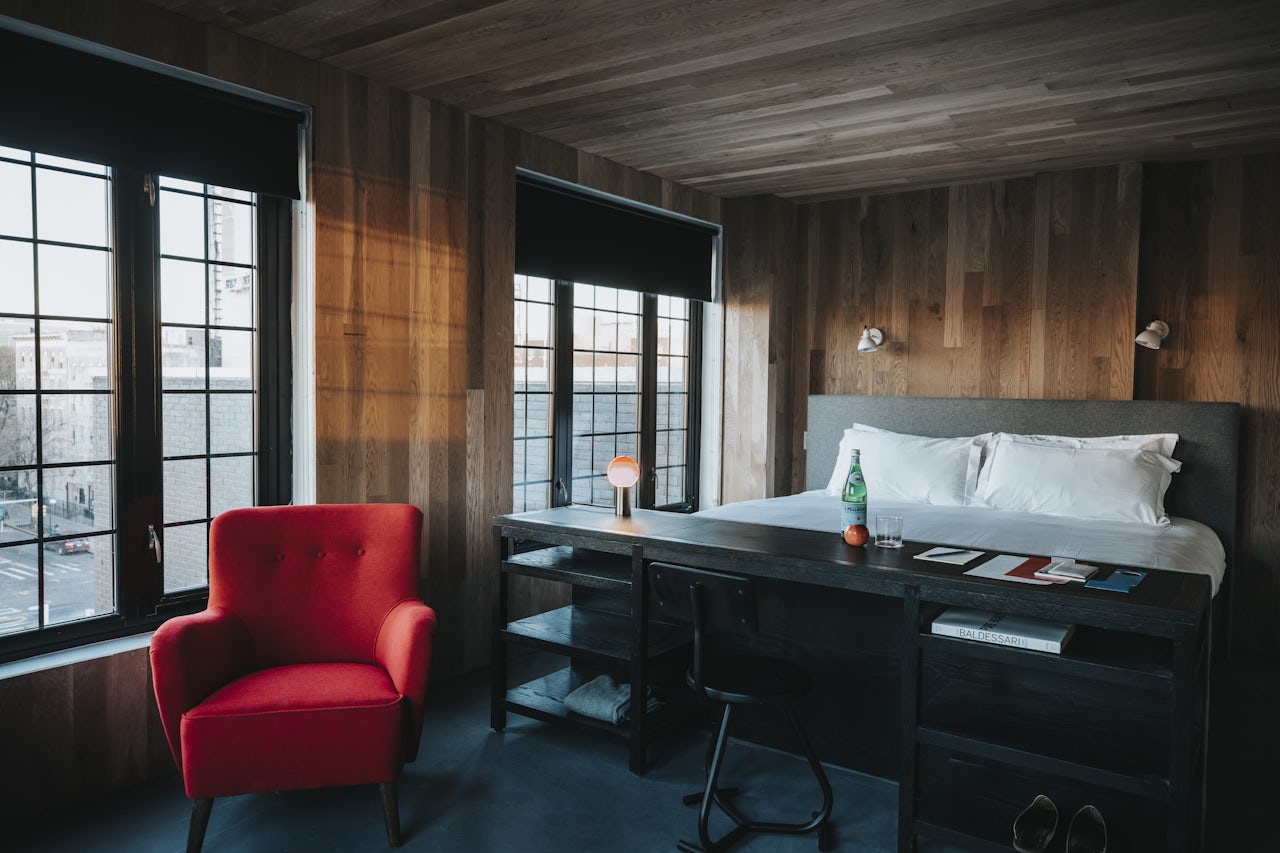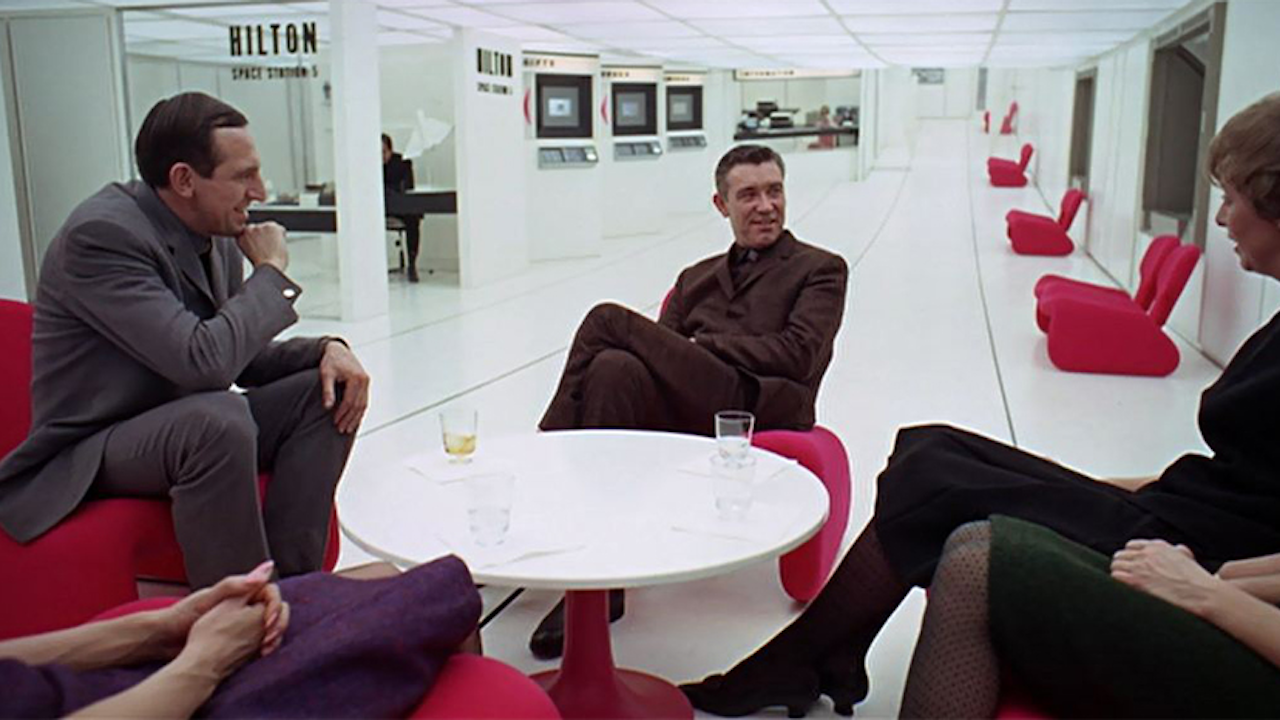The first thing I notice about the lobby of Moxy Times Square is the cornhole. The (Moxy-branded) lawn game, in which players attempt to launch bean bags through a hole in a tilted platform, is tucked to the side of the check-in kiosk, as if guests might spontaneously mount an athletic challenge to the hotel’s somewhat lethargic staff. “We have the largest hotel rooftop bar in the city,” my concierge says in a soft monotone. I have to strain to hear her. She hands me two tokens, good for two “Welcome” cocktails.
When I open the door to my 150-square-foot double room, I guffaw with glee at how utterly, egregiously, unapologetically small it is and immediately begin texting my friends pictures. It reminds me of the time well-known indie band Deerhunter performed at my preppy liberal arts college and, after surveying the pitiful turnout from the stage, lead singer Bradford Cox compared it to taking a shit so bad you want to send a photo to your friend.
Deerhunter aside, the accommodations are roughly the size of a first-class Amtrak sleeper car. The bed, with its supple, padded headboard, takes up the majority of the room, like a cloud wedged into a mountain cave. Sturdy hooks and a single wooden hanger (no closet) offer a place to put at least some of my things. The bathroom is tiled in public pool turquoise, except for the white tiles on the floor of the shower which spell out DEEP END. The shower has no door, and a rampart around the floor does not keep water from spilling over.
After receiving several affirming text messages, I go upstairs and deposit my two tokens with the bartender and drink my Jolly Rancher-flavored prosecco and strawberry “Welcome” cocktails before returning to my room and promptly falling asleep.
The rise of the microhotel is well-documented. Conde Nast Traveler has a particularly excellent primer on how Ian Schrager, hotelier and Studio 54 founder, ushered in the boutique hotel movement in the ’80s and ’90s like a clamshell ferrying Botticelli’s Venus out of the waves. These hotels were generally smaller, location-specific and more “conceptually oriented” than the average middle-market accommodations.
Then, in the 2000s, Alex Calderwood, the late co-founder of Ace Hotels, injected some rustic warmth into the chrome-and-martini splash of the Studio 54-era digs with Pendleton blankets and fat-bottomed diner mugs.
As Traveler notes, Calderwood and Ace birthed the idea of the minimal room and “curated” lobby. I suppose we can also hold them responsible for convincing adults to sleep in bunk beds, as I did at Providence’s The Dean in 2015.
The boutique hotel sold conceptual lodgings to the aspirational traveler. Ace injected them with hipster localism and authenticity as a countercultural statement. All there was left to do was shrink the rooms and double down on the concept — using guests, and their smartphones, as free marketers.
Enter: the microhotel.
Spurred on by Instagram, hotel rooms keep getting smaller even as shared spaces become increasingly hedonistic. At The Moxy’s Berlin location there is a large stuffed bear in a bathtub. I don’t know why. At Yotel Boston, a robot will roll up and greet you in the first floor and roof lounges, but a Premium Queen Cabin (rooms are called cabins) is a mere 152 square feet. CitizenM Amsterdam, which advertises “affordable luxury to the mobile citizens of the world” with “absolutely no trouser presses, bellboys, towel swans, or pillow chocolates,” offsets its 151 square foot rooms with a lobby crammed with objets d’art, including a Koonsesque balloon dog big enough to ride. “We believe everyone should have the best,” they say; all the rooms are the same size.
It no longer makes sense to talk about the microhotel trend in design terms alone when, to the average millennial, austerity is both a visual and economic condition. How the hell did personal space become equivalent to towel swans on the spectrum of extraneous luxuries?
Seeing as I spent less than two waking hours in my room but still Instagrammed the bathroom, I would say someone got their money’s worth and it wasn’t me.
Despite being better-connected and more well-educated than previous generations, millennials are less likely to buy a home in their early 30s, as Michael Hobbes explains in his piece “Millennials Are Screwed.” Our cohort, writes Hobbes, will “get less training and fewer opportunities to negotiate benefits through unions” while bearing the brunt of “the cost of education, the rise of contracting, [and] the barriers to skilled occupations,” all of which signal “an economy that has deliberately shifted the risk of economic recession and industry disruption away from companies and onto individuals.”
Just as the microhotel’s hedonistic lobby corresponds to its sparse bedroom, the experience-rich lives of millennials are intertwined with the personal financial burden of growing up post-recession. In this economic environment, luxury can never be possessed, only encountered and documented.
By adopting the architecture of a life oriented toward shallow, communal (and consumer) experiences, microhotels neither offer the best service nor save you money. Instead, they tell you to desire nothing more than a few feet around a bed frame, as long as the mattress is comfortable.
I should note that my stay at the Moxy wasn’t my first time there. I attended an opening party for the Marriott-brand hotel last October that showcased the common areas, designed by Rockwell Group. (The Canadian firm Yabu Pushelberg designed the hotel’s entry, public spaces and guest corridors and bedrooms.) The key draws of the rooftop spaces are a splashy miniature golf course called Foreplay, a carousel, and the ability to order a last-minute hotel room off the cocktail menu. The night of the party saw the addition of swings, basketball hoops, and a ball pit.
I wrote “seize the means of production” on the wall with a black light marker and went to find my friend, only to locate her struggling to extricate herself from aforementioned ball pit as influencers snapped selfies around her.
Downstairs, guests slept in their allotted compartments.
In an email, Glenn Pushelberg — one half of Yabu Pushelberg — takes issue with the idea that The Moxy is meant for millennials: “Society in general is shifting in its approach and appreciation for more pared-back living — to approach the concept of minimalism as if it’s only attractive to millennials is thinking too narrowly.”
His partner, George Yabu, adds, “As the luxury of space becomes more difficult to acquire in city centers, we wanted to create a built environment to correspond with what guests need when travelling.” Pushelberg’s “young-minded global nomad” does not come to New York to spend time in their room. (By the way, Moxy Chelsea will open in New York in October 2018.)
However, as someone who values their personal space, it’s hard not to see this emphasis on communal living as a consolation prize. I’ve lived in both Brooklyn and Manhattan. I’ve paid $800 in rent for a bedroom without a closet and $18 for a hostel bunk in Prague where the primary goals were to not get bedbugs and to meet some cool backpackers. Neither of these are experiences I want to be reminded of when I pay $220 for a hotel room in Times Square. Seeing as I spent less than two waking hours in my room but still Instagrammed the bathroom, I would say someone got their money’s worth and it wasn’t me.
Perhaps the best test of the deliberately constrained hotel room will come in fall 2018, when Atelier Ace — the design firm behind the Ace Hotel chain — launches a new property called Sister City in an old Bowery Salvation Army.
The design has been kept under wraps, but previews show a bed with built-in storage, compact shelving and wall hooks, all in the blond wood of a Finnish sauna. The property’s website toggles between electric blue and cool grey. “An Experiment In Essentialism” is scrawled across the landing page. A list of the property’s “inspirations” includes “Finnish saunas” and “Japanese bento boxes,” but also some intangibles like “soft feeling” and “spirit.”
“In terms of a demographic, we’re open to everyone that’s looking for a sanctuary in the city,” chief brand officer Kelly Sawdon said in Fast Company. Rooms will cost $259 per night. The hotel will also have a ground-floor restaurant — a risky proposition on a stretch that New York Magazine calls the “Bowery Death Stretch” due to its inability to sustain big-name restaurants.
“Technology is really allowing people to be their own concierge or curator and people are looking for experiences more than ever these days,” Sawdon recently told The New York Times, echoing the point that the city is an extension of the hotel’s footprint. Electrical outlets are listed among the hotel’s amenities, between such luxuries as “a roof” and “plants.”
“Sister City is a place that’s still encouraging people to go out and explore these cities, but it’s about having a place to come back to that’s quiet and calming,” Sawdon continued in the Times. That a sanctuary is by nature “essential” or minimal, is itself a value judgment but not an uncommon one. Marie Kondo, tiny houses, and Everlane have all been marketed the same way.
The brand has been teasing this juxtaposition over on their Instagram account, where rococo pastel colorfields are transposed over ambient street noise. Unlike Moxy, this is a room you can spend time in. An alternative to the sensory overload of late capitalism.
The Freehand Hotels are another boutique brand promising city-specific experiences in four US locations, including Manhattan. They don’t shy away from playing up the hostel-hotel hybrid, and advertise “Custom Artwork by Bard College Artists” next to their roster of adjacent restaurants and bars.
My friend and fellow writer Alexandra Marvar and her fiance, Hartford Gongaware, who is not a millennial, recently had drinks at the George Washington Bar — one of Esquire’s 21 Best Bars in America 2018. They then went upstairs to their room and things jumped the shark.
“Everything’s built for elves. The bed is a threat to your shins,” says Gongaware. The hotel includes George Washington Bar, Simon & The Whale Restaurant, Studio Restaurant & Bar and the Broken Shaker Rooftop Bar among its various offerings. But it was unclear to the couple whether the hotel exists to justify this stack of hip restaurants and bars or vice versa.
“The restaurants and the bar were the bread and butter of it. It’s not like you could hang out in the room,” says Marvar, who quickly realized that the scratchy throw pillow and stack of used, ermmm, vintage books made a lot more sense on Instagram. Gongaware noted there was nowhere in the bathroom to rest a razor, and that the only way to get to the far end of the bed was to take a running dive (he is six-foot-three).
“As someone who travels on my own dime for work, that’s the one space you have in these types of situations to compose yourself and breathe. It just doesn’t work for me. I don’t get it,” he says, adding, “There’s got to be a happy, human medium. You can function in a hotel room without threat of injury or compromise of dignity.”
Unfortunately, any concept once elevated can be de-elevated. Micro rooms may be charming in the hands of Ace — but once they trickle down the market, the concept makes for a frustrating hotel at best, and a dangerous one at worst.
The 1960s painting ’61 Pontiac by photorealist Robert Bechtle is a postcard from a bygone era. A family of four stands on a strip of neatly trimmed grass in front of their vehicle, the color of white gravy. They squint into the light. Baby gently grips mama’s breast — it’s Anystreet, USA.
“I remember being rattled by the middle-class ordinariness of the scene,” wrote New Yorker critic Peter Schjeldahl of the work.
The painting inspired the color scheme at Gowanus Inn & Yard, a Brooklyn hotel that launched in fall 2017. It’s a curious reference for a boutique hotel in industrial Gowanus. Even more unusual, once you realize that the hospitality that they are offering is far from the middle class comforts implied by Bechtle’s scene. In fact, the shortcomings of this hotel are the perfect metaphor for the financial marginalization of the young, millennial families it claims to cater to.
“We don’t want people to just come and stay in the rooms. Because generally that’s not why people come to New York,” says Rafael Prieto, co-founder and creative director of Savvy Studio, the design firm behind the hotel. Gowanus, and its famously malodorous canal, have a long history in manufacturing and shipping. The hotel was meant to draw upon that.
“The idea mainly was to not over-offer anything,” says Prieto, “I don’t think minimalism was the aim when we were designing the property, it was more about an industrialism in materials that would be related to the area.” A Junior Queen Suite is 180 square feet.
Despite write-ups in Interior Design Magazine and Dezeen extolling its exposed concrete lobby, bright communal sectionals, and built-in beds, the hotel has a dismal 1.5 star Yelp rating with plenty of horror stories as to how it is able to maintain its $93 budget-friendly price point. As with any hospitality project, the aspirations of its designers are at the mercy of bad management. (The hotel is affiliated with the Ascend Hotel Collection by Choice Hotels.)
A seemingly reasonable design rationale — minimal rooms and amenities for travelers more interested in attending a game at Barclays than ordering room service — provides slick cover for what is actually a failing hotel, no matter how cute it looks on Instagram.
“Lack of [room] phone to call front desk or, ya know, 911,” notes one traveler on Yelp. Another reviewer alleges they were given dirty sheets, and “when we called the front desk they said there is no cleaning staff they can bring us sheets to change it ourselves, which they never arrived with.” And yet another writes that the hotel ran out of towels during their March 2018 stay.
One group, after getting locked out, allegedly found an unmanned front desk with an emergency line that went to a rehab facility. (The hotel didn’t respond to The Outline’s invitation to respond to the Yelp reviews.)
The bright side? Prieto notes that if you want the entire place to yourself, Gowanus Inn & Yard is cheaper than surrounding AirBnB listings.
Besides, the branding is good.
“By the age of 35,” a recent meme lambasting tone-deaf financial advice for millennials, is a humorous take on just how much Millennials Are Screwed. “Forty-one percent of working millennials aren’t even eligible for retirement plans through their companies,” Hobbes writes. And yet, design trends have turned our surroundings into a playground with a (concealed) price.
By the age of 35, I will have attended a corporate pop-up claiming to be a museum. Refinery29 will have solicited my Plan B One-Step™ story for their 29Rooms installation. I will have my picture taken beside a large sign that says I <3 Baku, a month after an Azeri journalist was sentenced on trumped up charges. (I will not Instagram it.)
Truth be told, I’ve done all of these things eight years ahead of schedule.
I will witness public spaces and vacant real estate become what New York Magazine terms “heavily branded not-quite-retail, not-quite-gallery, meant-for-social-media spaces” rather than affordable housing. And I will be pushed out of my small apartment or, now hotel room, into these spaces — starting with the lobby. This crush of humanity will be termed “community.”
“Everyone who was staying in the hotel was so visible,” says Marvar of the Freehand. “You can tell who is a guest because they’re just like hanging out with their laptops. There’s some ghostly emulation of community, but its not of course real.”
Making shared space the draw of hotel design borders into co-living territory. I asked co-living startup Common, which has 20 homes across the United States offering private (furnished) bedrooms, shared suites, and compris utilities/cleaning how they felt about hotels veering into their turf. In their Williamsburg location, rents start at $2,050 for a private room. The average rent for a one-bedroom in the neighborhood is $2,890.
“You have the difference between a hotel being a one-night or a couple-night stay and [a place] where people are actually living,” says Sophie Wilkinson, the head of design and construction at Common. “By having that sustained interaction you build a community, I’m not sure how that happens in a hotel situation.” Zach Webb of The Baffler writes that Common retains community only in “atomized bits,” the result of “renters prepared to follow employment anywhere and all of the time.” Eloise lived at The Plaza — millennials live in AirSpace.
Immersive design experiences have a long history of upholding the economic status quo. Futuristic mid-century furniture designer Verner Panton, known for his “S” and heart-shaped seating, showcased many of his ideas through an installation in Cologne called Visiona which was sponsored by pharmaceutical company Bayer, who hoped to promote the design potential of their synthetic plastics. Of course, it was also a handy distraction from the fact that Bayer commercialized heroin and collaborated with Nazis. In 2016, the company acquired Monsanto — a company with its own troubled history.
“Pay no attention to that man behind the curtain!” such collaborations seem to say. This is the dark side of promising millennials hedonism in Instagrammable doses, but reserving austerity for the individual. We get cornhole instead of a real closet.
If you slash costs enough, you have to wonder whether guests are booking your hotel not for the design, but in spite of it. The irony is, there are plenty of staid hotel chains in midtown Manhattan of the same price range as the Freehand. When you strip out the social media cachet, many trendy hotels are a bum deal on par with the Kip’s Bay micro-apartment development, where tenants paid above market prices for less space.
I await the hotel equivalent of fashion’s normcore backlash, in which millennials are driven back to jewel-toned duvets and wicker kleenex holders reminiscent of Golden Girls. However, it’s just as likely that hotels will take feedback like Gongaware’s and rebrand a shaving shelf and extra-long bed as the Men’s Room™ — crafting a privilege out of standards that used to be the norm.
When I wake up from my post-dinner nap, it takes me a second to remember that I am in The Moxy. It’s 8:45 p.m. on July 9, 2018. If I hurry, I can be at the Magic Hour Rooftop Bar & Lounge when Donald Trump announces his Supreme Court nominee. In order to get upstairs, I have to leave the hotel and go around to a door with a velvet rope (another Ian Schrager invention). The bouncer stamps a black bat on the inside of my wrist that comes out looking like a winged smudge. On the roof, Where the Magic Happens is written in neon on a shrub. Down the block, Ernst & Young is written in its own electric lettering. A Nike billboard blinks.
I sit down and type, “Brett Kavanaugh Roe v. Wade” into Google. Out of the corner of my eye, the carousel crawls around. The bat stamp looks like the beginning of a weird disease. Over at Foreplay, there’s a statue of a plastic cat with perky tits pole dancing on the golf flag. A breasty squirrel is perched nearby. These sculptures are fixed in place — locked in to the bacchanal. The customer’s job is to buy enough $17 cocktails to join them.
Over the course of the night, I accidentally walk through several golf games. The line between playing and not playing is so thin. I long to return to my tiny compartment. It welcomes me.







